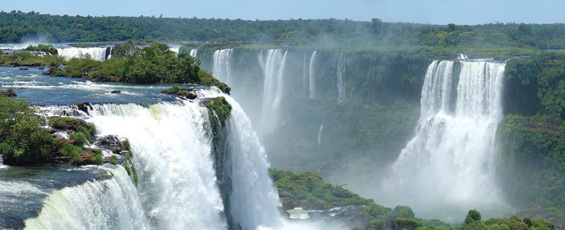
The very geography of the waterfalls at the Iguazu National Park makes them extraordinary. This long horseshoe-shaped string of impressive cataracts includes 275 magnificent waterfalls spread over nearly three kilometers. Much of this natural splendor is on Argentine soil, covering primarily more than 1,900 square meters that include the very heart of the falls. But Brazil also offers a crowning view of these tremendous falls, more than 800 meters wide. A broad vantage point overlooking San Martin Island is the point of access.
This island is situated on a rocky promontory in the Iguazu River, where a ferry shuttles hikers back and forth. Visitors will take home vivid memories of both sides of the park, each as memorable as the other.
As you enter the subtropical forest, you’ll be welcomed by luxuriant fauna and flora. Native animals include the tapir, howler monkey, ocelot, jaguar, and crocodile. Winged wonders abound too, in the form of over 400 bird species. And nearly 2,000 types of plants have been documented.
The great dusky swift is ingenious, plunging within the cascading water to hide and construct its nest there, away from predators. Parakeets brighten the landscape and delight the ear with their outstanding musicality.
Devil’s Throat
As you soar high above the waterfalls, a deep chasm comes into view. It’s as if the land succumbed to tremendous tension when the waterfalls were being created, the kind of tension that comes from over 200,000 years of shifting tectonic plates. Millions of drops of water have cascaded over these falls since that time, enrapturing souls, bodies, and minds. The longest drop, 90 meters tall, was christened Garganta del Diablo or Devil’s Throat. Prepare to see breathtaking rainbows, a frequent occurrence since these powerful waterfalls give off a continuous fine mist.
Some of the adjectives used to describe the falls might seem exaggerated or even pretentious. But Iguazu National Park is currently a finalist in the competition to select the “New Seven Wonders of Nature.” This international initiative involves a lengthy selection process that stretches over a five-year period. Entries included 440 distinctive sites from more than 220 countries. The final selection will be announced in July 2011. As you might have guessed, this international recognition takes its inspiration from the seven wonders of the world of ancient Greece.
Three Musketeers Falls
These falls are a nod to the Alexandre Dumas novel and subsequent film by the same name. The vast panorama that unfolds before you is truly memorable.
An Eco-Tourism Destination Since 2001
You can soundlessly explore the subtropical forest’s flora and fauna aboard the natural gas–powered Rainforest Ecological Train, traveling through 15 kilometers that might as well be in another world! Board at the main terminal for travel to the Waterfalls or Devil’s Throat stations.
The upper and lower parts of the Iguazu River boast a system of secure walkways. And note that on the Brazilian side, an elevator takes you another 20 meters higher. The upper trails afford a panoramic view of the park.
Macuco Trail (allow 3 hours)
Seasoned hikers will be serenaded by subtropical forest animals with the roar of the falls in the background. Find new inner peace as you take this contemplative hike, complete with meditative pauses.
Moonlight Tours
If you visit when the moon is full, don’t miss the chance to see the falls at their mythical, poetic best.
The Falls in Color
In September and October, American vegetation flaunts its most beautiful colors and Iguazu National Park is no exception.
River Rafting
The gutsiest visitors can enjoy shooting the rapids on inflatable boats.
A Bit of History
Originally christened St. Marie Falls, the cataracts are today called Iguazu, a name that means “big water” in Guarani, the native tongue.
The falls were discovered by explorer Alvar Nuñez Cabeza de Vaca in the 16th century. Iguazu National Park, which covers 67,620 hectares, was established in 1934 on the Argentina–Brazil border and has just observed the 76th anniversary of its founding. The Argentine section of the falls was designated a UNESCO World Heritage Site in 1984, and the Brazilian section of the falls received the same designation in 1986.